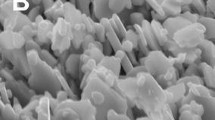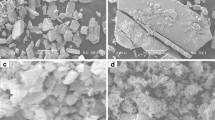Abstract
The structure and morphology of ammonium metatungstate (AMT), (NH4)6[H2W12O40]⋅4H2O, and its thermal decomposition in air and nitrogen atmospheres were investigated by SEM, FTIR, XRD, and TG/DTA-MS. The cell parameters of the AMT sample were determined and refined with a full profile fit. The thermal decomposition of AMT involved several steps in inert atmosphere: (i) release of crystal water between 25 and 200 °C resulting in dehydrated AMT, (ii) formation of an amorphous phase between 200 and 380 °C, (iii) from which hexagonal WO3 formed between 380 and 500 °C, and (iv) which then transformed into the more stable m-WO3 between 500 and 600 °C. As a difference in air, the as-formed NH3 ignited with an exothermic heat effect, and nitrous oxides formed as combustion products. The thermal behavior of AMT was similar to ammonium paratungstate (APT), (NH4)10[H2W12O42]⋅4H2O, the only main difference being the lack of dry NH3 evolution between 170 and 240 °C in the case of AMT.








Similar content being viewed by others
References
Lassner E, Schubert WD. Tungsten properties, chemistry, technology of the element, alloys, and chemical compounds. New York: Kluwer Academic/Plenum Publishers; 1999.
Hammond C, Straus J, Righettoni M, Pratsinis SE, Hermans I. Nanoparticulate tungsten oxide for catalytic epoxidations. ACS Catal. 2013;3:321–7.
Di Valentin C, Wang F, Pacchioni G. Tungsten oxide in catalysis and photocatalysis: hints from DFT. Topics Catal. 2013;56:1404–19.
Veith GM, Lupini AR, Pennycook SJ, Alberto V, Prati L, Dudney NJ. Magnetron sputtering of gold nanoparticles onto WO3 and activated carbon. Catal Today. 2007;122:248–53.
Phuruangrat A, Ham DJ, Hong SJ, Thongtem S, Lee JS. Synthesis of hexagonal WO3 nanowires by microwave-assisted hydrothermal method and their electrocatalytic activities for hydrogen evolution reaction. J Mater Chem. 2010;20:1683–90.
Szilágyi IM, Fórizs B, Rosseler O, Szegedi Á, Németh P, Király P, Tárkányi G, Vajna B, Varga–Josepovits K, László K, Tóth AL, Baranyai P, Leskelä M. WO3 photocatalysts: influence of structure and composition. J Catal. 2012;294:119–27.
Lin CT, Tsai TH. Solution volume effect of photodegradation by 1-D WO3 nanorods via microwave-assisted solvothermal heating under the UV irradiation. Asian J Chem. 2013;25:7098–102.
Nandiyanto ABD, Arutanti O, Ogi T, Iskandar F, Kim TO, Okuyama K. Synthesis of spherical macroporous WO3 particles and their high photocatalytic performance. Chem Eng Sci. 2013;101:523–32.
Liu BX, Wang JS, Li HY, Wu JS, Zhou ML, Zuo TY. Facile synthesis of hierarchical hollow mesoporous Ag/WO3 spheres with high photocatalytic performance. J Nanosci Nanotech. 2013;13:4117–22.
Karacsonyi E, Baia L, Dombi A, Danciu V, Mogyorosi K, Pop LC, Kovacs G, Cosoveanu V, Vulpoi A, Simon S, Pap Z. The photocatalytic activity of TiO2/WO3/noble metal (Au or Pt) nanoarchitectures obtained by selective photodeposition. Catal Today. 2013;208:19–27.
Szilágyi IM, Saukko S, Mizsei J, Tóth AL, Madarász J, Pokol G. Gas sensing selectivity of hexagonal and monoclinic WO3 to H2S. Solid State Sci. 2010;12:1857–60.
Szilágyi IM, Wang L, Gouma PI, Balázsi C, Madarász J, Pokol G. Preparation of hexagonal WO3 from hexagonal ammonium tungsten bronze for sensing NH3. Mater Res Bull. 2009;44:505–8.
Balázsi C, Wang L, Zayim EO, Szilágyi IM, Sedlackova K, Pfeifer J, Tóth AL, Gouma PI. Nanosize hexagonal tungsten oxide for gas sensing applications. J Eur Ceram Soc. 2008;28:913–7.
Szilágyi IM, Saukko S, Mizsei J, Király P, Tárkányi G, Tóth AL, Szabó A, Varga-Josepovits K, Madarász J, Pokol G. Controlling the composition of nanosize hexagonal WO3 for gas sensing. Mater Sci Forum. 2008;589:161–5.
Wang L, Pfeifer J, Balázsi C, Szilágyi IM, Gouma PI. Nanostructured hexagonal tungsten oxides for ammonia sensing. Proceedings of SPIE—The International Society for Optical Engineering Nanosensing: Materials, Devices, and Systems III. 2007;6769:67690E.
Balázsi C, Sedlackova K, Pfeifer J, Tóth AL, Zayim EA, Szilágyi IM, Wang LS, Kalyanasundaram K, Gouma PI. Synthesis and examination of hexagonal tungsten oxide nanocrystals for electrochromic and sensing applications. NATO Science for Peace and Security Series C: Environmental Security; Sensors for Environment, Health and Security. 2009:77–91.
Kukkola J, Mohl M, Leino AR, Maklin J, Halonen N, Shchukarev A, Konya Z, Jantunen H, Kordas K. Room temperature hydrogen sensors based on metal decorated WO3 nanowires. Sens Actuat B. 2013;186:90–5.
Zhang YD, He WW, Zhao HX, Li PJ. Template-free to fabricate highly sensitive and selective acetone gas sensor based on WO3 microspheres. Vacuum. 2013;95:30–4.
Chromčíková M, Liška M, Lissová M, Mošner P, Koudelka L. Structural relaxation of PbO–WO3–P2O5 glasses. J Therm Anal Calorim. 2013;114:947–54.
Shen Y, Zhu H, Huang R, Zhao L, Yan SN. Synthesis and photochromic properties of WO3 powder induced by oxalic acid. Sci China Ser B. 2009;52:609–14.
Cai GF, Zhou D, Xiong QQ, Zhang JH, Wang XL, Gu CD, Tu JP. Efficient electroctrochromic materials based on TiO2@WO3 core/shell nanorod arrays. Solar Energy Mater Solar Cell. 2013;117:231–8.
Hongjie L, Zhang L. An overview on synthetic methods of benzyl acetate. Eur Chem Bull. 2013;2:272–4.
Blovská V, Bělina P, Šulcová P. Synthesis of tungstate pigments of the formula MNd2W2O10 (M = Ni, Zn, Mn). J Therm Anal Calorim. 2013;113:83–9.
Łącz A, Pasierb P. Synthesis and properties of BaCe1−x Y x O3−δ –BaWO4 composite protonic conductors. J Therm Anal Calorim. 2013;113:405–12.
Biedunkiewicz A, Szymczyk A, Chrosciechowska J. Oxidation of (Ti, W)C ceramic powders. J Therm Anal Calorim. 2004;77:75–83.
Kano S, Inoue T. Surface softening and hardening of WC–Co using pulsed laser irradiation. Surf Coat Tech. 2006;201:223–9.
Kim HC, Shon IJ, Yoon JK, Doh JM. Consolidation of ultra fine WC and WC–Co hard materials by pulsed current activated sintering and its mechanical properties. Int J Refract Metal Hard Mater. 2007;25:46–52.
Moreno-Castilla C, Alvarez-Merino MA, Carrasco-Marín F, Fierro JLG. Tungsten and tungsten carbide supported on activated carbon: surface structures and performance for ethylene hydrogenation. Langmuir. 2001;17:1752–6.
Szymańska-Kolasa A, Lewandowski M, Sayag C, Djéga-Mariadassou G. Comparions of molybdenum carbide for the hydrodesulfurization of dibenzithiophene. Catal Today. 2007;119:7–12.
Szilágyi IM, Madarász J, Pokol G, Hange F, Szalontai G, Varga-Josepovits K, Tóth AL. The effect of K+ ion doping on the structure and thermal reduction of hexagonal ammonium tungsten bronze. J Therm Anal Calorim. 2009;97:11–8.
Bartha L, Neugebauer J. Aspects of effective doping and the incorporation of dopant. Int J Refract Metal Hard Mater. 1995;13:1–34.
Pink E, Bartha L. The metallurgy of doped/non-sag tunsgten. London: Elsevier; 1989.
van Put JW. Crystallisation and processing of ammonium paratungstate (APT). Int J Refract Metal Hard Mater. 1995;13:61–76.
Bartha L, Kiss BA, Szalay T. Chemistry of tungsten oxide bronzes. Int J Refract Metal Hard Mater. 1995;13:77–91.
Szilágyi IM, Santala E, Heikkilä M, Pore V, Kemell M, Teucher G, Firkala T, Färm E, Nikitin T, Khriachtchev L, Räsänen M, Ritala M, Leskelä M. Photocatalytic properties of WO3/TiO2 core-shell nanofibers prepared by electrospinning and atomic layer deposition. Chem Vapor Dep. 2013;19:149–55.
Szilágyi IM, Santala E, Heikkilä M, Kemell M, Nikitin T, Khriachtchev L, Räsänen M, Ritala M, Leskelä M. Thermal study on electrospun polyvinylpyrrolidone/ammonium metatungtate nanofibers: optimising the annealing conditions for obtaining WO3 nanofibers. J Therm Anal Calorim. 2011;105:73–81.
Christian JB, Whittingham MS. Structural study of ammonium metatungstate. J Solid State Chem. 2008;181:1782–91.
Fait MJG, Lunk HJ, Feist M, Schneider M, Dann JN, Frisk TA. Thermal decomposition of ammonium paratungstate tetrahydrate under non-reducing conditions characterization by thermal analysis, X-ray diffraction and spectroscopic methods. Thermochim Acta. 2008;469:12–22.
Prasad RL, Kushwaha A, Szilágyi IM, Kótai L. Solid state thermal degradation behaviour of 1-D coordination polymers of Ni(II) and Cu(II) bridged by conjugated ligand. J Therm Anal Calorim. 2013;114:653–64.
Szilágyi IM, Deák A, Várhelyi C Jr, Madarász J, Pokol G, Gömöry Á, Várhelyi C. Structural and thermal study of assymetric α-dioxime complexes of Co(III) with Cl and methyl-pyridines. Polyhedron. 2010;10:2185–9.
Zhang HY, Xu L, Wang EB, Jiang M, Wu AG, Li Z. Photochromic behavior and luminescent properties of novel hybrid organic–inorganic film doped with Preyssler’s heteropoly acid H12[EuP5W30O110] and polyvinylpyrrolidone. Mater Lett. 2003;57:1417–22.
Li Y, Li YG, Zhang ZM, Wu Q, Wang EB. A new polyoxotungstate-based W72V30 spherical cage. Inorg Chem Commun. 2009;12:864–7.
Duplyakin VK, Baklanova ON, Chirkova OA, Antonicheva NV, Arbuzov AB, Voitenko NN, Drozdov VA, Likholobov VA. Interaction of nickel hydroxocarbonate, ammonium paramolybdate, and ammonium metatungstate under mechanical activation. Kin Catal. 2010;51:126–30.
Sunita G, Devassy BM, Vinu A, Sawant DP, Balasubramanian VV, Halligudi SB. Synthesis of biodiesel over zirconia-supported isopoly and heteropoly tungstate catalysts. Catal Commun. 2008;9:696–702.
Sarish S, Devassy BM, Böhringer W, Feltcher J, Halligudi SB. Liquid-phase alkylation of phenol with long-chain olefins over WO /ZrO2 solid acid catalysts. J Mol Catal A. 2005;240:123–31.
Szilágyi IM, Pfeifer J, Balázsi C, Tóth AL, Varga-Josepovits K, Madarász J, Pokol G. Thermal stability of hexagonal tungsten trioxide. J Therm Anal Calorim. 2008;94:499–505.
Madarász J, Szilágyi IM, Hange F, Pokol G. Comparative evolved gas analyses (TG-FTIR, TG/DTA-MS) and solid state (FTIR, XRD) studies on thermal decomposition of ammonium paratungstate tetrahydrate (APT) in air. J Anal Appl Pyrol. 2004;72:197–201.
Mansour SAA, Mohamed MA. Thermal decomposition and the creation of reactive solid surfaces. V. The genesis course of the WO3 catalyst from its ammonium paratungstate precursor. Thermochim Acta. 1988;129:187–96.
French GJ, Sale FR. A re-investigation of the thermal decomposition of ammonium paratungstate. J Mater Sci. 1981;16:3427–36.
Szilágyi IM, Madarász J, Hange F, Pokol G. On-line evolved gas analyses (EGA by TG-FTIR and TG/DTA-MS) and solid state (FTIR, XRD) studies on thermal decomposition and partial reduction of ammonium paratungstate tetrahydrate. Solid State Ionics. 2004;172:583–6.
Szilágyi IM, Madarász J, Hange F, Pokol G. Partial thermal reduction of ammonium paratungstate tetrahydrate. J Therm Anal Calorim. 2007;88:139–44.
Szilágyi IM, Hange F, Madarász J, Pokol G. In situ HT-XRD study on the formation of hexagonal ammonium tungsten bronze by partial reduction of ammonium paratungstate tetrahydrate. Eur J Inorg Chem. 2006;17:3413–8.
Szilágyi IM, Sakó I, Király P, Tárkányi G, Tóth AL, Szabó A, Varga-Josepovits K, Madarász J, Pokol G. Phase transformations of ammonium tungsten bronzes. J Therm Anal Calorim. 2009;98:707–16.
Szilágyi IM, Madarász J, Király P, Tárkányi G, Tóth AL, Szabó A, Varga-Josepovits K, Pokol G. Stability and controlled composition of hexagonal WO3. Chem Mater. 2008;20:4116–25.
Acknowledgements
I. M. S. thanks for a János Bolyai Research Fellowship of the Hungarian Academy of Sciences and an OTKA-PD-109129 grant.
Author information
Authors and Affiliations
Corresponding author
Rights and permissions
About this article
Cite this article
Hunyadi, D., Sajó, I. & Szilágyi, I.M. Structure and thermal decomposition of ammonium metatungstate. J Therm Anal Calorim 116, 329–337 (2014). https://doi.org/10.1007/s10973-013-3586-1
Received:
Accepted:
Published:
Issue Date:
DOI: https://doi.org/10.1007/s10973-013-3586-1




